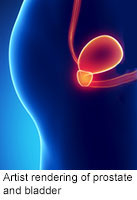Lower survival for intermediate-risk disease, compared to low-risk cases
TUESDAY, Feb. 24, 2015 (HealthDay News) — Choosing active surveillance over treatment for prostate cancer may decrease the odds of survival in men with intermediate-risk cancer, according to research scheduled to be presented at the American Society of Clinical Oncology’s (ASCO) annual Genitourinary Cancers Symposium, held from Feb. 26 to 28 in Orlando, Fla.
Researchers analyzed data for 945 prostate cancer patients in Canada between 1995 and 2013. All had chosen active surveillance of their disease. Two hundred thirty-seven of the men had intermediate-risk prostate cancer, and 708 had low-risk cancer. If the cancer progressed during surveillance, patients were offered radiation therapy or surgery. Eighty-six men in the intermediate-risk group received treatment, according to the researchers.
Overall survival rates after 10 and 15 years were 68 and 50 percent, respectively, for intermediate-risk patients. That compared to 84 and 69 percent, respectively, for low-risk patients. Overall, the researchers found that patients with intermediate-risk disease were almost four times more likely to die than those with low-risk disease.
“For low-risk patients with prostate cancer managed with active surveillance, the risk of dying of prostate cancer is low, validating this approach for this group of patients,” D. Andrew Loblaw, M.D., a radiation oncologist at Sunnybrook Health Sciences Centre in Toronto, said in an ASCO news release. But, he added, more research is needed to determine which intermediate-risk patients can safely be monitored and which patients need treatment sooner.
Copyright © 2015 HealthDay. All rights reserved.








